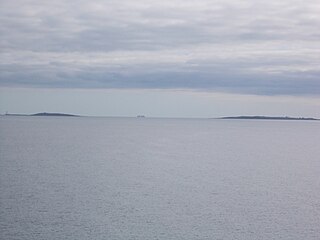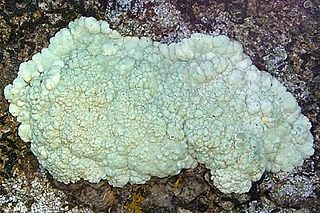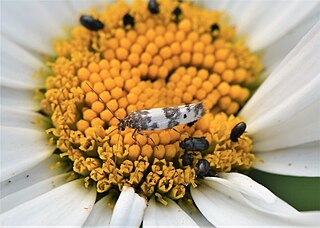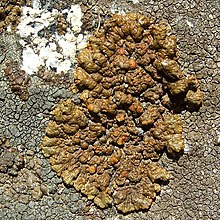
The Copeland Islands is a group of three islands in the north Irish Sea, north of Donaghadee, County Down, Northern Ireland, consisting of Lighthouse Island, Copeland Island, and Mew Island. They lie within the civil parish of Bangor.
Irwin M. Brodo is an emeritus scientist at the Canadian Museum of Nature, in Ottawa, Ontario, Canada. He is an authority on the identification and biology of lichens. Irwin Brodo was honored in 1994 with an Acharius Medal presented to him by the International Association for Lichenology.

Lecanora is a genus of lichen commonly called rim lichens. Lichens in the genus Squamarina are also called rim lichens. Members of the genus have roughly circular fruiting discs (apothecia) with rims that have photosynthetic tissue similar to that of the nonfruiting part of the lichen body (thallus). Other lichens with apothecia having margins made of thallus-like tissue are called lecanorine.

Lecanora hybocarpa is a species of crustose lichen in the family Lecanoraceae. Originally described in 1849 as a species of Parmelia, it was transferred to Lecanora in 1984 by Irwin Brodo.

Lecanora laxa is a species of lichen in the family Lecanoraceae.

Lecanora phryganitis is a species of lichen in the family Lecanoraceae. It was described as new to science in 1866 by American botanist Edward Tuckerman.

Lecanora is a species of crustose lichen in the family Lecanoraceae. It was described as new to science in 1864 by American botanist Edward Tuckerman.

Lecanora pringlei is a species of lichen in the family Lecanoraceae. It was originally described in 1883 as Lecidea pringlei by American botanist Edward Tuckerman. Ivan Mackenzie Lamb transferred it to Lecanora in 1939.

Lecanora thysanophora is an eastern North American lichen in the family Lecanoraceae. It is a common crustose species, easily recognized by its sorediate thallus, usually encircled by a grey prothallus.

Enolmis acanthella is a moth of the family Scythrididae. It was described by Jean-Baptiste Godart in 1824. It is found in north-western Africa, Portugal, Spain, Italy and Switzerland. The species is spreading its distribution area. It was first sighted in France near Nancy in 1988 and since 1991 it regularly occurs in the city of Luxembourg. In 1998, it was also found in south-eastern Luxembourg and in 1999, it was collected in Saarland, Germany.

Lecanora polytropa, commonly known as the granite-speck rim lichen, is a species of saxicolous lichen in the family Parmeliaceae. A small, inconspicuous species that grows in the cracks of rock surfaces, it has a cosmopolitan distribution and has been recorded on all continents, including Antarctica.
Lecanora vainioi is a species of crustose lichen in the family Lecanoraceae. It is found in Brazil, where it grows on granitic rocks. It was described as a new species in 1986 by Finnish botanist Heino Vänskä. The epithet vainioi honours lichenologist Edvard Vainio (1853–1929), who did pioneering work on the Brazilian lichens.
Lecanora kohu is a species of lichen in the family Lecanoraceae. Found in the Chatham Islands of New Zealand, it was formally described as new to science in 2017.
Lecanora inaurata is a species of crustose lichen in the family Lecanoraceae. Found in the United States, it was described as new to science in 2016 by Caleb Morse and Douglas Ladd. The lichen occurs in open hardwood-dominated woodlands of the Edwards Plateau and grasslands of the southern Great Plains in Oklahoma and Texas. It is a member of the L. subfusca group in genus Lecanora.
Lecanora achroa is a species of crustose lichen in the family Lecanoraceae. It was originally described in 1876 by Finnish botanist William Nylander from specimens collected in Rodrigues, Mauritius. The lichen is found in Australia, New Zealand, Papua New Guinea, and North and South America.
Lecanora lichexanthona is a species of crustose and saxicolous (rock-dwelling) lichen in the family Lecanoraceae. Found in Brazil, it was formally described as a new species in 2000 by lichenologist Roland Guderley. The type specimen was collected by Klaus Kalb in a closed cerradão between Rio Verde de Mato Grosso and Coxim where it was found growing on siliceous rock. The specific epithet lichexanthona refers to the presence of the chemical lichexanthone as a major secondary in the lichen. Other compounds in the lichen are atranorin, hybocarpone, constipatic acid, and norlichexanthone. Lecanora lichexanthona is only known to occur in cerradão formations in central Brazil, at altitudes between 500 and 850 m.
Lecanora substerilis is a species of corticolous (bark-dwelling), crustose lichen in the family Lecanoraceae. It is found in Eastern Europe, in old-growth beech forests of the Carpathian Mountains in the Czech Republic, Slovakia, Romania and Ukraine.
Lecanora ussuriensis is a species of saxicolous (rock-dwelling) lichen in the family Lecanoraceae. It is found in single localities in the Primorsky Krai region of the Russian Far East, as well as in Japan.










